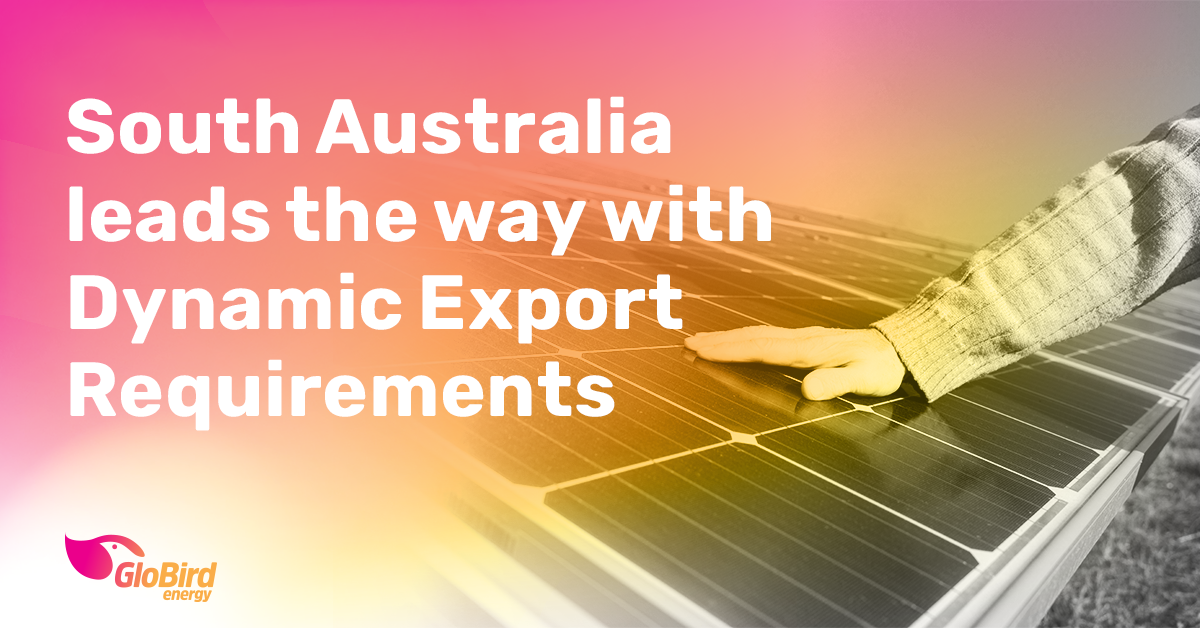Earlier this year, we explained that flexible export limits were coming for South Australian rooftop solar owners (see our post A world-first is changing the game for rooftop solar owners).
Now that we’ve passed the July 1st introduction date, we’ve got some more detail on the significant new regulations that have been implemented in South Australia and what that means for residential solar customers in that state.
We understand that it’s highly likely that the other states will follow the South Australian lead, although at this stage we have no indication of potential or proposed timings.
About Dynamic Export Requirements
The South Australian government has introduced what it’s called Dynamic Export Requirements.
These regulations mandate that new and upgraded exporting solar generation systems must be capable of remotely updating their export limits.
The reason for the implementation of these new standards is something GloBird Energy has been talking about for some time: too much rooftop-solar-generated energy is being put into the grid at times when demand just isn’t there.
This has been a challenge for some time, and Australians are still installing more than 200,000 new PV systems a year across the national electricity market (NEM). This impacts the value of energy at different times of the day and is one of the main reasons we released our Free Lunch energy plan that offers customers free electricity every day from 12:00 midday to 2pm.
How SA Power Networks has explained it
“Solar has been so popular in South Australia that some parts of the electricity distribution network can be congested by solar exports at certain times when energy demand is low. That can cause voltage issues for all customers, and it can mean solar customers’ inverters trip off or ramp down.
To respond to this challenge SA Power Networks introduced the Flexible Exports trial in September 2021. Customers in trial areas can export up to 10kW from their solar panels with dynamically capable inverters being lowered for limited periods to avoid overloading the network.
To coincide with the changes in regulations, SA Power Networks will commence a progressive roll out of Flexible Exports as a standard connection option from 1 July 2023.
Beginning with 37 suburbs currently in the trial it will be expanded to more suburbs. We expect that Flexible Exports will be available in most suburbs by mid-2024. All inverters which meet the SA Government Regulations will be compatible with the Flexible Exports offer.”
This hasn’t come about overnight
Even though you might not have heard about this until now (or back in March, when we posted our earlier article), the need for change has been on the cards for some time.
The NEM works with the various networks that distribute electricity throughout the eastern states (including South Australia) to make sure there is enough generation capacity to meet consumer demand, but at the same time has to ensure the system is secure.
Too much energy being generated but unused is just as big a problem as running low, as far as the security and reliability of the infrastructure is concerned.
Maintaining the ‘right’ amount of energy in the grid was much easier when all the electricity was coming from a fixed number of locations (power plants) managed by companies in the business of energy generation.
The policymakers, regulators, and operators have had to adapt to the significant change that’s been happening over the past 20 years, where more and more energy is being generated and exported to the grid by randomly distributed individuals, with a real concentration in some places.
Things have changed over the past couple of years
The rate of solar ownership had reached such heights that in some areas SA Power Networks (SAPN) had no option but to reduce the fixed export limit for new installs from the standard 5kW to only 1.5kW. Elsewhere some network service providers export limited homes to zero.
Meanwhile, inverters that can vary the amount they export in response to a signal from the network were developed and have steadily become more readily available to householders and installers.
Last October, the Australian Energy Regulator (AER) released a paper on flexible export limits and found that stakeholders were overwhelmingly in favour of the technology.
SAPN was already running a 12-month field trial involving about 600 customers to test the viability of this kind of connection arrangement and refine and develop the associated technologies.
During the trial, participating households with a capable array and inverter were able to export up to 10kW, but SAPN had the ability to remotely turn down this flow to 1.5kW when there was a need to ‘throttle back’ the supply.
What this means for rooftop solar owners
A recent study by the Australian National University found that, if they had access to dynamic export limits, customers could export three times the energy they are exporting now.
This means that if the energy can be generated and moved at the right time – when there is demand – there is significant capacity for more rooftop-solar-generated energy to be exported and used. Solar feed-in values are also changing so that savvy customers can access the additional value of their feed-in when the market values it most.
Although the average Australian domestic house roof can accommodate a 10kW array, fixed limits have been a disincentive to installing systems with that capacity. The most common size for new installs is a 6.6kW array with a 5kW inverter, to match the standard export limit.
In other words, this change should pave the way for even more rooftop solar energy in the future, along with the associated upside for those households and all consumers: more reliable, cheaper, greener electricity.
